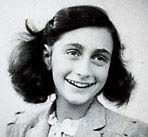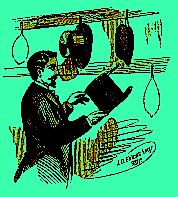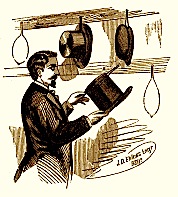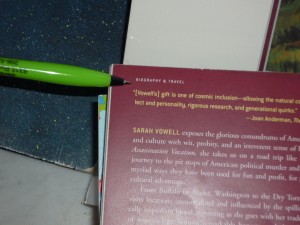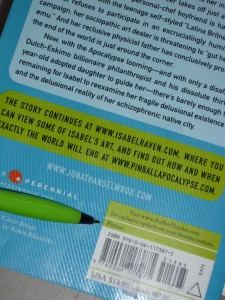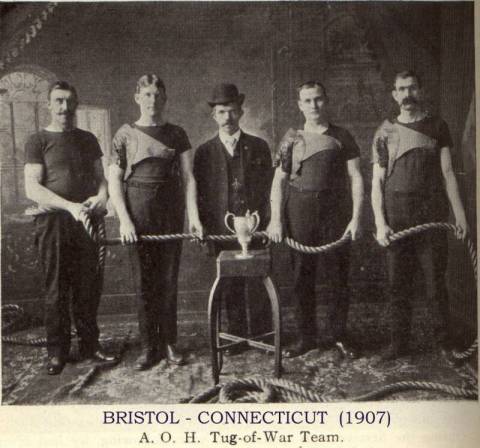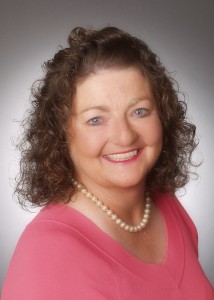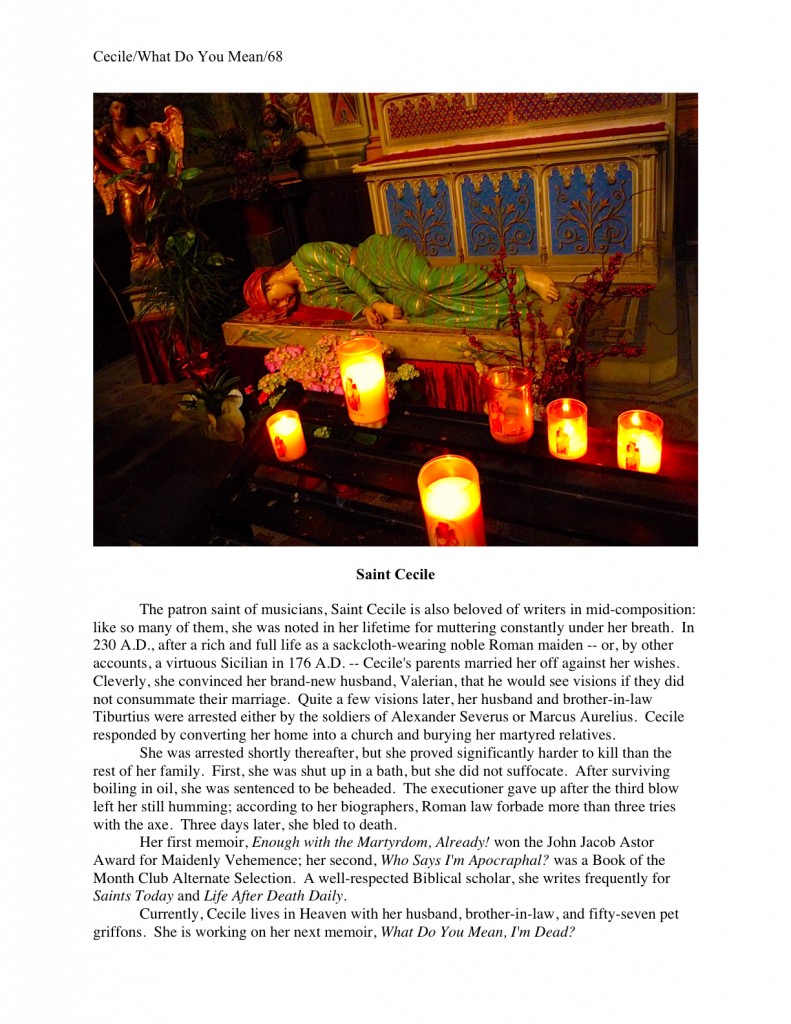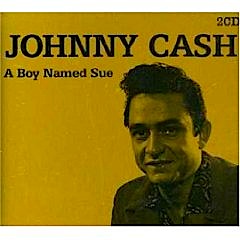





Sorry about my recent slow rate of posting, campers; as the sharper-eyed among you may have noticed, we here at Author! Author! have been experiencing what the old television shows used to call euphemistically technical difficulties. Quite a bit of progress can be seen behind the scenes, I assure you, but it will be a little while before the full benefits will be visible from your side of the page. Mea culpa, and thanks for hanging in there.
I’ve been hesitant to keep pressing forward with our series-in-progress on manuscript formatting while the visual examples are still acting a bit squirrelly. Writers’ conference season is almost upon us, however, and proper formatting can make the difference between an enthusiastically-read post-pitch submission and one that our old pal, Millicent the agency screener, picks up with trepidation, so I’d like to smuggle the standard format basics into everyone’s writing tool kit sooner rather than later. Let us press on unabashed, therefore.
When last we broached the subject, I showed how the first page of text does not, from a professional perspective, make an adequate substitute for a title page in a book manuscript — a demonstration that, if past is any prologue, may well have left some of you scraping your jaws off the floor. Don’t be too hard on yourself, if so: most first-time submitters simply assume that if a manuscript does include a title page — and a hefty majority of submissions arrive without one — it should be a replica of a hoped-for book cover. That’s what they’ve seen in bookstores (ask your grandparents, children), so that must be what looks professional to the professionals, right?
As I hope those of you who have been following his series have already shouted: heavens, no. Standard format for manuscripts does not resemble what’s on the printed page of a published book in many respects.
You’d be surprised at how many aspiring writers are not aware of that, judging by how many single-spaced, non-indented, photo-heavy submissions turn up at agencies. Even the more industry-savvy rookies — the ones who have taken the time to learn that book manuscripts must be double spaced, contain indented paragraphs, be printed on one side of the page, etc. — are frequently unaware that that in traditional publishing circles, the author typically has very little say over what does and does not grace the cover.
Millicent is quite cognizant of that fact, however; experience watching books travel the often bumpy road from initial concept to publication have shown her that cover art is almost invariably the publishing house’s choice. So is pretty much everything on the dust jacket, including the back jacket copy, the book’s typeface, and every other cosmetic consideration. So when she opens requested materials to find something like this:
she sees not a manuscript perfectly ready for publication — that’s what some of you, thought, right? — but evidence that the sender does not understand the difference between a published book and a manuscript. At minimum, this admittedly rather pretty top page demonstrates that the writer does not understand that throughout the publication process, the title page of a manuscript is not just its top cover.
Nor is it merely the shouted-out declaration of the book’s title and who wrote it, another popular choice in submissions. What possible practical purpose could a title page like this serve at the submission stage?
Not much doubt about what it’s called or who wrote it, true, and the typeface certainly blares those two facts with gratifying gusto, but how precisely does this (unusually small, for some reason best known to the writer) sheet of paper fulfill any of the functions the agent or small publisher to whom it was submitted might need it to serve? How, in fact, is it a better title page than the most common of all, the following?
No, your eyes are not deceiving you: the single most popular title page option in manuscript submissions is none. It’s an especially common omission in e-mailed submissions. Half the time, e-mail submitters don’t even include a cover letter; they just attach the requested number of pages. “I’ve been asked to send this,” title page-eschewers murmur, doubtless to convince themselves, “so the agency has to know who I am. Besides, my name and the title are in the slug line — that’s the writer’s name and title in the upper right margin of the page, should anyone have been wondering. Surely, that’s enough to identify the manuscript.”
Well, it might be, if Millicent were fond of guessing games, but hands up, anyone who seriously believes that agents ask to see so few manuscripts in any given year based upon the tens of thousands of queries they receive that any requested materials must be instantly recognizable not only to their weary peepers, but to the entire staffs of their agencies. Keep those hands up if you also cling to the writer-flattering notion that agents and editors hearing pitches at conference find so few of them convincing that they could easily identify both book and writer by the storyline alone.
Found better uses for your hands, did you? Glad to hear it. But if presenting a fantasy book cover isn’t the point of including a title page, and if its main goal is not to shout that you — yes, YOU — managed to pull off the quite impressive achievement of writing an entire book or book proposal, what meaning is this poor, misunderstood page supposed to convey to Millicent?
Its mission is not particularly romantic, I’m afraid: a properly-formatted title page is simply a quiet, practical piece of paper, containing a specific set of marketing information any agent or editor would need in order to bring your book to publication. If Millicent doesn’t spot that information as soon as she claps eyes on the pages her boss, the agent of your dreams, asked you to send, her first impression of your submission will be that you’ve made her life a little harder.
Call me zany, but I doubt that was Ann Gardiner’s goal when she put all of that effort into designing that pretty faux book cover and popped it into the envelope with her first 50 pages. I would be surprised if Ama Narcissist actively desired to make it difficult for an agent who fell in love with her writing to contact her. And I would be downright flabbergasted if the e-mailing submitter that just didn’t think to include a title page with his Word document hadn’t just assumed that Millicent keeps every single one of the thousands of e-mails her agency receives in any given week in a special file, all ready to be leafed through so if her boss wants to see more of the manuscript, she can waste 17 hours trying to track down the sender’s original e-mailed query. Because all that’s required to respond to an e-mailed submission is to hit REPLY, right?
Again: heavens, no. Any reasonably established agency may be relied upon to be juggling far, far too many submissions at any given time.
Do those inarticulate gasps of frustration mean that some of you have under-labeled manuscripts in circulation at this very moment, or merely that you have questions? “But Anne,” hyperventilating writers the English-speaking world over gasp, “I’m an inveterate reader of agency and small publishing houses’ submission guidelines, and they rarely state a preference for including a title page. What gives?”
What gives, my air-deprived friends, is that it’s actually pretty uncommon for submission guidelines to get down to the nitty-gritty of page formatting. As much as the strictures of standard format may seem new and strange to an aspiring writer confronting them for the first time, it’s just how the publishing industry expects professional book writing to be presented. A title page is so presumed to be part of a properly-formatted manuscript that many submission guidelines might not bother to mention it at all.
Which may be why, in practice, submitting without a title page is far more common than including one, especially for electronic submissions. This presentation choice is particularly common for contest entries, perhaps because contest rules seldom come right out and say, “Hey, buddy, include a title page, why doncha?” — and they virtually never say, “Hey, buddy, don’t bother with a title page, because we don’t need it.” Instead, they usually just ask entrants to include certain information with their entries: the category the writer is entering, perhaps, with contact information on a separate sheet of paper.
Which has, you may be interested to hear, a name amongst those who handle manuscripts for a living. It’s called, if memory serves, a title page.
Ah, a forest of hands has sprouted in the air. “But Anne,” murmur those of you who currently have submissions floating around out there without your contact information attached, “I’d like to go back to that part about the expectation that a manuscript should include a title page being so widespread that a pro putting together submission guidelines might not even think to bring it up. Assuming that pretty much everyone else whose submission will land on Millicent’s desk on the same day as mine was in the dark about this as I was until I read your recent fine-yet-sleep-disturbing post, should I even worry about not having included a title page? I mean, if Millie were going to reject manuscripts on this basis alone, she’d be a non-stop rejection machine.”
Of course, she isn’t a non-stop rejection machine. She’s a virtually non-stop rejection machine. She genuinely gets excited about quite a few submissions.
But that wasn’t really the crux of your question, was it, worried submitters? You’re quite right that this omission is too common to be an instant-rejection offense at most agencies, despite the fact that including it renders it far, far easier for the agent of your dreams to contact you after he has fallen in love with your writing. However, any deviation from standard format on page 1 — or, in the case of the title page, before page 1 — will make a manuscript look less professional to someone who reads submissions day in, day out. It lowers expectations about what is to follow.
To gain a better a sense of why, let’s revisit a couple of our examples from earlier in this series. Welcome back, R.Q. Snafu and Faux Pas. See if you can spot where they went astray.
While opening pages like these do indeed include the requisite information Millicent or her boss would need to contact the author (although Faux Pas’ pulls it off it better, by including more means of contact), cramming all of it onto the first page of text doesn’t really achieve anything but saving a piece of paper, does it? What precisely would be the point of that? This tactic wouldn’t even shorten the manuscript or contest entry, technically speaking: the title page is never included in a page count. That’s why pagination begins on the first page of text.
So what should a proper title page for a book manuscript or proposal look like? Glad you asked:
Got all three of those last three images indelibly burned into your cranium? Excellent. Now weigh the probability that someone who reads as many manuscripts per day as Millicent — or her boss, or the editor to whom her boss likes to sell books — would not notice a fairly substantial difference in the presentation.
Exactly. Now assess the likelihood of that perception’s coloring any subsequent reading of the manuscript in question.
The answers are kind of obvious once you’ve seen the difference, are they not? Trust me, Millicent will have seen the difference thousands of times.
Again, I see many raised hands out there in the ether. “But Anne,” upright individuals the globe over protest, “I get that including all of the information in that last example would render it simpler for a Millicent who fell in love with the first three chapters of MADAME BOVARY to contact Mssr. Flaubert to ask for the rest of the manuscript. I’m not averse to making that part of her job as easy as humanly possible. However, I don’t quite understand why my presentation of that array of facts need be quite so visually boring. Wouldn’t my manuscript be more memorable — and thus enjoy a competitive advantage — if the title page were unique?”
At the risk of damaging your tender eardrums, HEAVENS, no! To folks who handle book manuscripts for a living, a title page is most emphatically not the proper place for individual artistic expression; it’s the place to — stop me if you’ve heard this before — provide them with specific information necessary for dealing with a submission.
Anything else is, in a word, distracting. To gain a sense of why, let’s take a gander at another type of title page Millicent sees with great frequency — one that contains all of the right information, but is so unprofessionally formatted that the care with which the writer followed the content rules gets entirely subsumed in the visuals.

Where should I even begin with this one? It’s pretty, undoubtedly, but would anyone care to start listing any of the five things wrong with it?
If you immediately zeroed in on the picture, give yourself a gold star for the day. Since there is literally no chance that any image a writer chooses to place on a manuscript or proposal’s title page will end up on the published book’s cover, what’s the point of placing it here? Decorating your submission’s title page with photos or drawings will just seem bizarre to Millicent. (And that goes double for Mehitabel, the veteran literary contest judge. She is likely to emit a well-bred little scream when she opens the entry envelope.)
Award yourself two gold stars if you said Ms. White should nix the red lettering — or any lettering that isn’t black, for that matter. Like every other page in the manuscript, the title page should be printed in black ink on white paper. No exceptions.
Help yourself to a third gold star out of petty cash if you also caught that her contact information should not have been centered. Pin a great big blue ribbon on yourself, too, if you pointed out that Ms. White used two different typefaces here, a classic standard format no-no. Not to mention the fact — although I do seem to be mentioning it, don’t I? — that the type size varies.
Feel free to chant it with me, axiom-lovers: like everything else in the manuscript, the title page should be entirely in 12-point type. It should also be in the same font as the rest of the manuscript.
With the usual caveat: unless an agent specifically requests otherwise, of course. Or contest’s rules; double-check for title page restrictions. (Why? Well, since the title page is generally the first part of an entry Mehitabel sees, not adhering to the rules there can knock an otherwise promising submission out of finalist consideration before she has a chance to read the first line of text. Contest rules exist for a reason, you know.)
You may place the title — and only the title — in boldface if you like, but that’s about as far as it’s safe to venture on the funkiness scale. Do not, I beg you, give in to the temptation of playing with the typeface. No matter how cool your title page looks with 24-point type, resist the urge, because Millicent will be able to tell from across the room if you didn’t.
Don’t believe that size matters? See for yourself:
Quite a difference, isn’t it? Apart from Mssr. Smith’s tragic font choice and his not having countermanded Word’s annoying propensity to reproduce e-mail addresses in blue ink, did you notice any potentially-distracting problems with this title page?
If you said that the last example included both a slug line and a page number in the bottom right corner, snag yourself yet another gold star. Add whipped cream and walnut clusters if you mentally added the reason that those additions are incorrect: because the title page is not the first page of text, and should not be formatted as if it were.
While I’m on a boldface kick, title pages should not be numbered. This means, incidentally, that the title page should not be counted as one of the 50 pages in those 50 pages the agent of your dreams asked you to submit. Nor would it count toward the total number of pages for a contest entry.
That loud whoop you just heard was contest-entering writers everywhere realizing that they could squeeze another page of text into their entries. Who knew so many of them could tap-dance?
While you’ve got those title pages firmly imprinted upon your brainpan, let me briefly address a question from incisive reader Lucy, one of many aspiring writers enamored of the clean, classic look of initials on a book cover. As you may have noticed, our pall Snafu shares the same preference. Lucy wondered if other naming choices might raise other distracting thoughts.
What if you have a weird name which is gender confusing? Say a boy named Sue? Should he put Mr. Sue Unfortunate on his title page? Or just Sue Unfortunate?
Lucy’s responding, of course, to the fine print on R.Q.’s first page. Here it is again, to save you some scrolling:
I was having a little fun in that last paragraph with the still surprisingly common writerly belief that the agents and editors will automatically take a submission by a woman more seriously if the author submits it under her initials, rather than under her given first name. J.K. Rowling aside, this just isn’t true, at least in fiction circles.
In fact, in North America, women buy the overwhelming majority of novels — and not just women’s fiction, either. A good 90% of literary fiction readers (and agents, and editors) have two X chromosomes — and some of them have been known to prefer reading books by Susans rather than Roberts.
So unless you have always hated your parents for christening you Susan, you won’t really gain anything professionally by using initials in your nom de plume instead. Go ahead and state your name boldly, Sue.
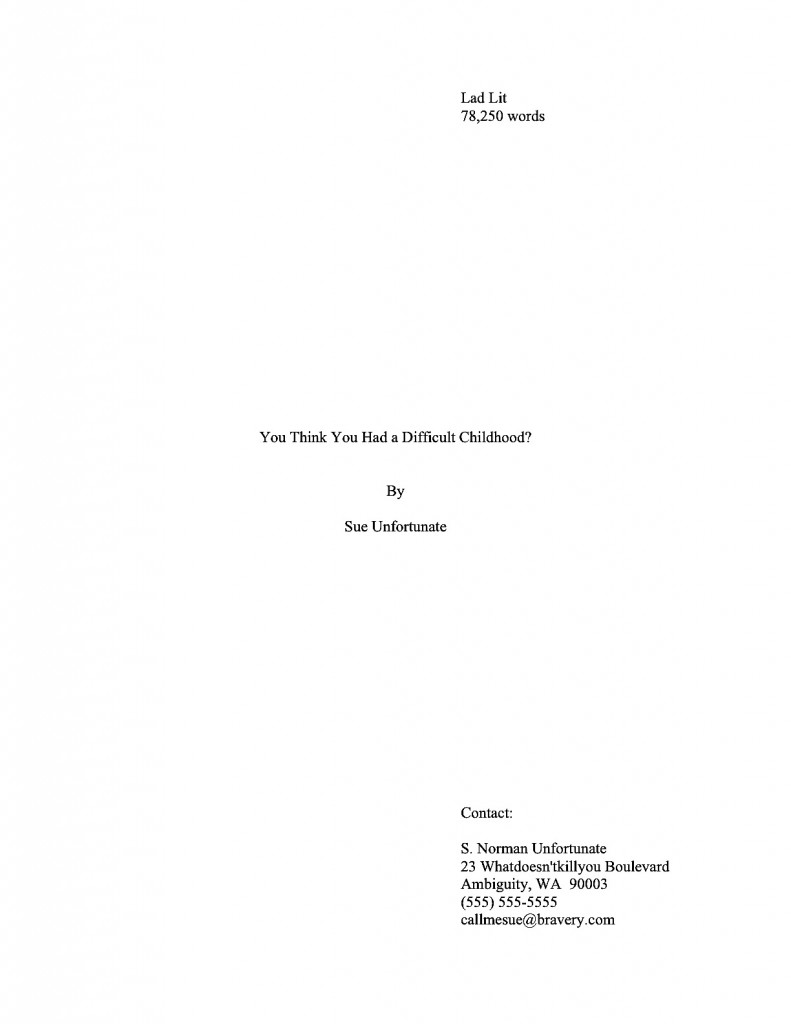
Even better, why not publish under a name you actually like instead? That’ll show your Susan-loving parents, Norm.
I just ruffled a few feathers out there, didn’t I? “But Anne,” I hear many an initialed purist exclaim, “I don’t want to be judged as a female writer; I want to be judged as a writer. What’s wrong with removing gender markers altogether from my title page — or my query letter, for that matter?”
Well, there’s nothing wrong with it per se, Susan, except that people are probably going to leap to a conclusion about your sex regardless, at least if you happen to be writing in a book category that tends to be marketed more to one sex than another. In most fiction and pretty much all nonfiction categories, Millicent’s first response upon seeing initials on a title page, especially if neither the By part and the contact information contain a first name, will often be, “Oh, this is a female writer who doesn’t want to be identified as one,” rather than “Gee, I wonder who this intriguing person without a first name is. I’m just going to leap right into this manuscript with no gender-based expectations at all.”
Why might young Millie have this reaction — and her older boss be even more likely to respond this way? Because female writers (and with a few notable exceptions, almost exclusively female writers) have been submitting this way for a couple of hundred years now. It’s not all that hard a code to crack.
Historically, the hide-my-sex-for-success strategy has been used far, far less by male authors — except, of course, that hugely prolific and apparently immortal author, Anonymous, and the reputedly male writers of such ostensibly female-penned first-person classics of estrogen-fueled wantonness (avert your eyes, children) as THE HAPPY HOOKER, COFFEE, TEA, OR ME? and MEMOIRS OF A GEISHA. Even during periods when some of the most popular and respected novelists have been women (and there have been quite a few such periods in the history of English and American prose, contrary to what your high school English textbook probably implied), when someone named Stanley Smith wrote a novel, the title page has generally said so.
Because, you see, even back in the 19th century, many readers would have just assumed S. Smith the novelist was a nice lady named Susan. (It’s probably where your parents got the idea to christen you that, Norman.) Or those readers would have assumed that you were an Oxford don writing scurrilous fiction that might have shocked your colleagues on the side. That avocation has historically resulted in fewer book readers naming their children Susan, though.
That being said, an author’s pen name is ultimately up to the author. The choice to identify yourself with initials or not is entirely up to you — or, more accurately, to you and your agent, you and your editor, and you and your future publisher’s marketing department. Some sets of initials look cooler than others in print, just as some names look better than others on book jackets.
Or so claimed my father, the intrepid fellow who demanded that the maternity ward nurse convey him to a typewriter to see how my name looked in print before committing to filling out my birth certificate. The better to check if it would look good on a book jacket, my dear. So for those of you who have wondered: however improbable it sounds, Anne Mini is in fact my given name; it just happens to look great in print, thanks to a little paternal forethought.
If I had preferred to publish under A. Mini, though, I doubt anyone but my father would have strenuously objected. Certainly not at the submission stage — when, for some reason that mystifies Millicents, many aspiring writers seem to believe that the question of pen name must be settled for good. It doesn’t. Should you already be absolutely certain that you would prefer to go by your initials, rather than your given name, feel free to identify yourself that way on your title page.
For convenience’s sake, however, it’s customary for the contact information to list the name one prefers an agent to ask to speak to on the telephone.
Which brings us back to Lucy’s trenchant question: how on earth does a writer with a gender-ambiguous name delicately convey whether s/he would prefer to be addressed as Ms. or Mr.? S/he doesn’t, at least on the title page, or indeed in the query letter: that’s a matter for subsequent conversation with one’s agent. These days, though, it’s unlikely that the agent who has just fallen in love with the writer of our last example would address a potential client so formally: the e-mail or phone call offering representation would probably begin Dear Norman.
At worst, an agent reading in a hurry might call and ask for Ms. Unfortunate. But you can live with that, can’t you, Susan?
Besides, unless a writer’s gender (or sex, for that matter) is crucial to the story being told, why should it come up before then?
See earlier commentary about being judged by one’s writing, not one’s sex. If a writer is genuinely worried about it, s/he could always embrace Norman’s strategy above, and use a more gender-definite middle name in the contact information.
Keep your chins up, Susans everywhere — you may have little control over what literary critics will say about your work, but you do have control over what name they call will you while they’re doing it. That’s worth something, isn’t it?
More concrete examples of properly and improperly formatted manuscripts follow next time. Keep those questions coming, and as always, keep up the good work!












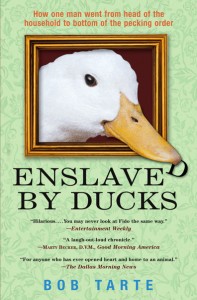 When Bob Tarte left the city of Grand Rapids, Michigan for the country, he was thinking peace and quiet. He’d write his music reviews in the solitude of his rural home on the outskirts of everything.
When Bob Tarte left the city of Grand Rapids, Michigan for the country, he was thinking peace and quiet. He’d write his music reviews in the solitude of his rural home on the outskirts of everything.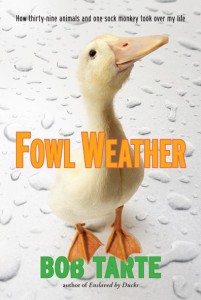 Bob Tarte’s second book, Fowl Weather, returns us to the Michigan house where pandemonium is the governing principle, and where 39 animals rule the roost. But as things seem to spiral out of control, as his parents age and his mother’s grasp on reality loosens as she battles Alzheimer’s disease, Bob unexpectedly finds support from the gaggle of animals around him. They provide, in their irrational fashion, models for how to live.
Bob Tarte’s second book, Fowl Weather, returns us to the Michigan house where pandemonium is the governing principle, and where 39 animals rule the roost. But as things seem to spiral out of control, as his parents age and his mother’s grasp on reality loosens as she battles Alzheimer’s disease, Bob unexpectedly finds support from the gaggle of animals around him. They provide, in their irrational fashion, models for how to live.


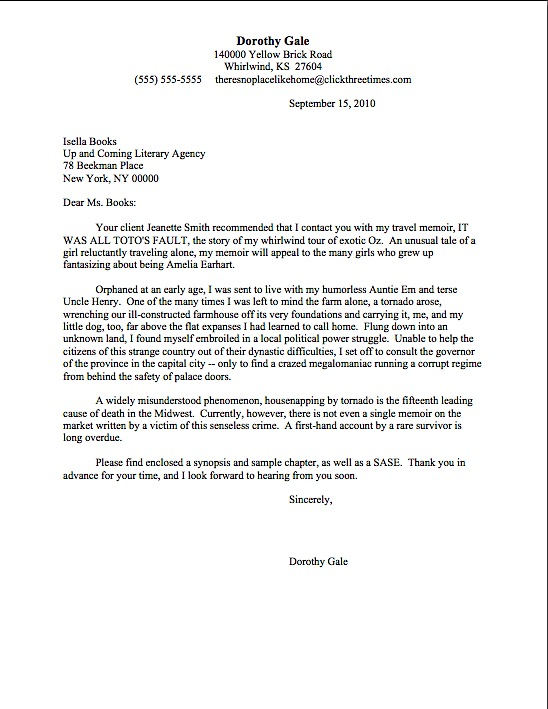
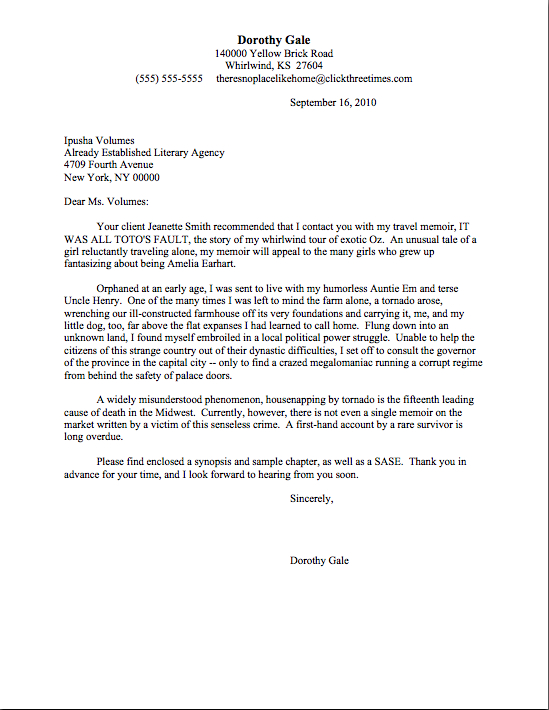



 The vast majority of queries are not read in their entirety before being rejected. Therefore, the first paragraph of your query is one of the very few situations in the writing world where you need to tell, as well as show.
The vast majority of queries are not read in their entirety before being rejected. Therefore, the first paragraph of your query is one of the very few situations in the writing world where you need to tell, as well as show.


